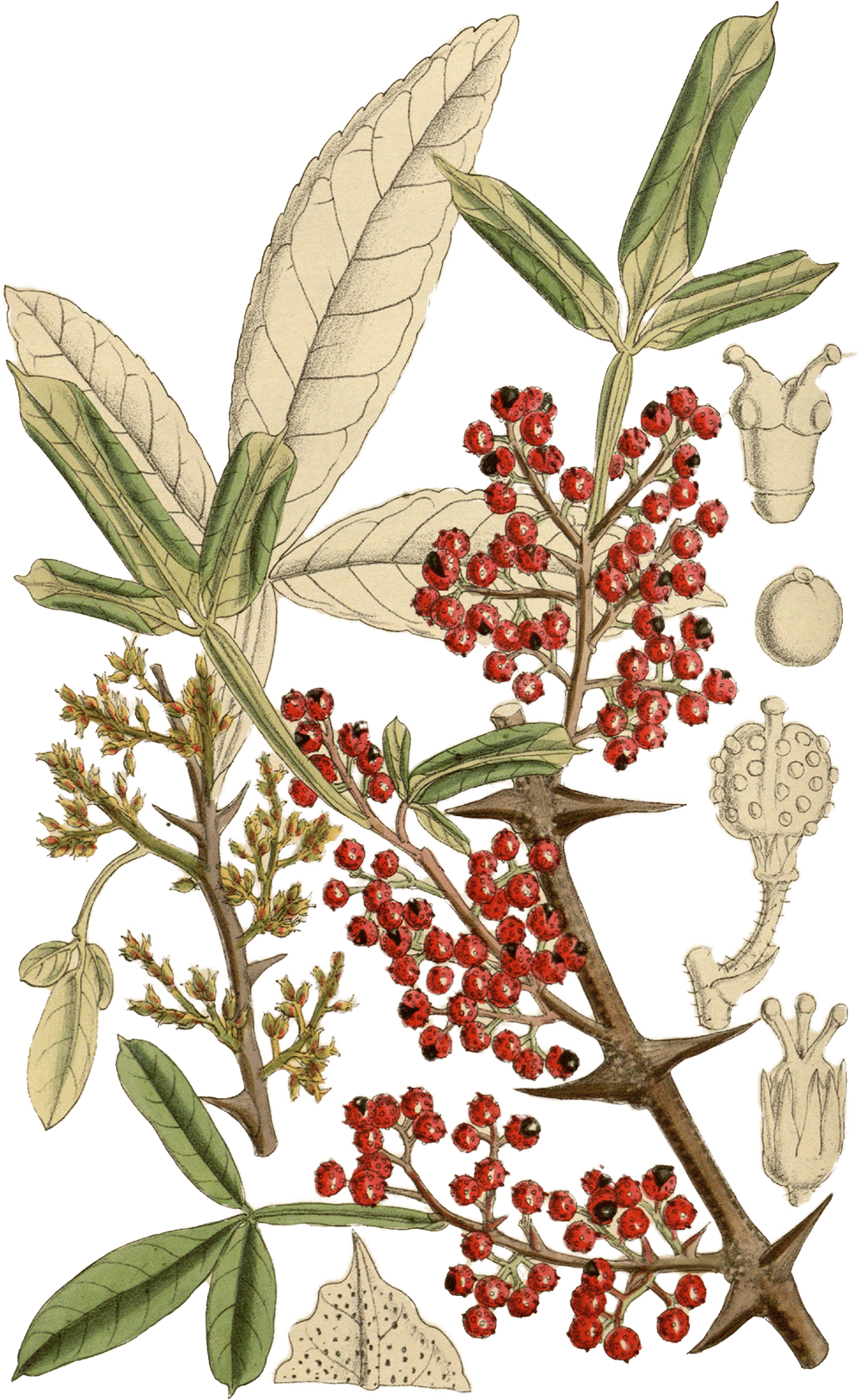Sichuan Pepper #

Illustration of Zanthoxylum bungeanum Maxim. from Matilda Smith (del.), John Nugent Fitch (lith.). (1918) Zanthoxylum planispinum (= Zanthoxylum armatum), Rutaceae. In Curtis's Botanical Magazine (Ed. Sir David Prain), London., vol. 144 [= ser. 4, vol. 14]: Tab. 8754.
Sichuan Pepper (Zanthoxylum bungeanum Maxim.) is a culinary spice from the Rutaceae family,1 originating in the region(s) of China.2 It is used for its pericarp, primarily for meats; colic. Its aroma is described as woodsy, peppery, with a heat index of 3.3
| English | Arabic | Chinese | Hungarian |
|---|---|---|---|
| Sichuan pepper | فلفل سيتشوان | 花椒 | szecsuáni bors |
Overview #
| id | Sichuan pepper |
|---|---|
| species name | Zanthoxylum bungeanum Maxim. |
| family | Rutaceae |
| part used | pericarp |
| macroarea | Asia |
| region of origin | China |
| cultivation | China |
| color | red; green |
| botanical database | POWO |
Etymologies #
English Sichuan pepper
English fagara < Medieval Latin fagara ‘Sichuan pepper?; cubeb?’, translingual word from scientific Latin; coined by European botanists reading Avicenna (cf. da Orta) < Arabic فاغرة fāghira < Persian fākhira
Arabic فلفل سيتشوان fulful sītshuwān ‘Sichuan pepper’
Mandarin Chinese 花椒 huājiāo ‘Sichuan pepper’ [flower-pepper ]
Names #
English #
| term | source |
|---|---|
| Sichuan pepper | Van Wyk, 2014 |
| anise pepper | Austin, 2008 |
| brown pepper | Austin, 2008 |
| Chinese pepper | OED |
| Chinese prickly ash | |
| winged prickly ash | |
| chuan jiao | Van Wyk, 2014 |
| zhu ye jiao | Van Wyk, 2014 |
| fagara | Austin, 2008 |
| sancho | Van Wyk, 2014 |
| Japanese pepper | OED |
| Japanese prickly-ash | |
| Nepal pepper | Austin, 2008 |
| prickly ash | OED |
| yue jiao | Van Wyk, 2014 |
| sansho | Van Wyk, 2014 |
| timut | Van Wyk, 2014 |
Arabic #
| script | term | literal | source |
|---|---|---|---|
| فلفل سيتشوان | fulful sītshuwān | Sichuan pepper | Wikipedia |
| فاغرة | fāghira | open | Lane, 1863 |
Chinese #
| script | term | literal | source |
|---|---|---|---|
| 花椒 | huājiāo | flower-pepper | Defrancis, 2003 |
| 川椒 | chuānjiāo | river(=Sichuan)-pepper | Hu, 2005 |
| 麻椒 | májiāo | numbing-pepper | |
| 青花椒 | qīnghuājiāo | green-flower-pepper | Hu, 2005 |
| 日本花椒 | rìběn huājiāo | Japanese-flower-pepper | |
| 山椒 | shānjiāo | mountain-pepper | Wikipedia |
| 蜀椒 | shǔjiāo | Sichuan-pepper | Wikipedia |
| 香椒子 | xiāngjiāozi | fragrant-pepper-seed | Hu, 2005 |
| 崖椒 | yájiāo | cliff-pepper | Hu, 2005 |
| 竹葉椒 | zhúyèjiāo | bamboo-leaf-pepper | |
| 椒 | jiāo | pepper | Defrancis, 2003 |
POWO. (2022). Plants of the World Online (Botanical Database). Facilitated by the Royal Botanic Gardens, Kew. http://www.plantsoftheworldonline.org/ ↩︎
van Wyk, B.-E. (2014). Culinary Herbs and Spices of the World. University of Chicago Press, joint publication with the Royal Botanic Gardens, Kew. https://doi.org/10.7208/chicago/9780226091839.001.0001 ↩︎
Medicinal Spices Exhibit. (2002). UCLA Biomedical Library: History & Special Collections. https://unitproj.library.ucla.edu/biomed/spice/index.cfm?spicefilename=taste.txt&itemsuppress=yes&displayswitch=0 ↩︎